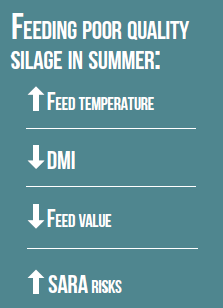Blog | Reading Time 2 minutes
Heat stress management starts in the silo!
Heat stress is a well-established and growing issue for ruminants across the world. It has a huge financial impact linked to both milk and meat yield reduction and also a longer-term impact on animal health. Housing, nutrition and herd management are important to limit heat stress risks and impact, but forage quality shouldn’t be overlooked, meaning that heat stress management requires planning ahead!
Why silage quality is even more important in summer ?
 When ensiled forage represents a major part of daily feeding, it’s essential the silage produced is of the highest quality possible. Poorly fermented and preserved silages are often of lower feed quality and tend to heat considerably at feedout and, as such, animals will avoid eating this silage. Moreover, aerobically unstable silages help create an ideal environment for natural populations of undesirable yeast and mold to proliferate, lowering both nutritive values and palatability while also significantly increasing dry matter (DM) loses. Heating silage could see its nutritive value decrease by as much as 16% before molds become visible (Borreani et al, 2018) and DM losses can be more than 15%. Poor quality silage is also prone to higher levels of some mycotoxins such as deoxynivalenol, which has negative effects on rumen microflora and will upset the microbial balance in the rumen. As a result, the already stressed animal will be placed in further danger of Sub Acute Ruminal Acidosis (SARA) development.
When ensiled forage represents a major part of daily feeding, it’s essential the silage produced is of the highest quality possible. Poorly fermented and preserved silages are often of lower feed quality and tend to heat considerably at feedout and, as such, animals will avoid eating this silage. Moreover, aerobically unstable silages help create an ideal environment for natural populations of undesirable yeast and mold to proliferate, lowering both nutritive values and palatability while also significantly increasing dry matter (DM) loses. Heating silage could see its nutritive value decrease by as much as 16% before molds become visible (Borreani et al, 2018) and DM losses can be more than 15%. Poor quality silage is also prone to higher levels of some mycotoxins such as deoxynivalenol, which has negative effects on rumen microflora and will upset the microbial balance in the rumen. As a result, the already stressed animal will be placed in further danger of Sub Acute Ruminal Acidosis (SARA) development.
Focus on silage management
Silage management is the first key to improve the silage quality and stability at feedout, even under hot temperatures. The best management practices should be implemented at harvesting. It is important to pack the silo properly, seal it with good quality plastic (oxygen barrier plastic, if possible) and weigh the cover down correctly. Using an appropriate forage inoculant is crucial in producing the best quality silage possible. Products containing bacteria that have been tested extensively and independently, such as Lactobacillus buchneri NCIMB 40788, have been proven to inhibit yeasts and mold development in the silo and at feedout. This not only reduces DM and energy losses of the silage, it also ensures high-quality silage, especially during the more challenging summer months.
For more tips on silage management, visit our brand new website www.qualitysilage.com
Published Aug 5, 2019 | Updated May 30, 2023
Related articles
Need specific information?
Talk to an expert